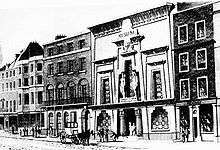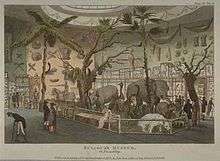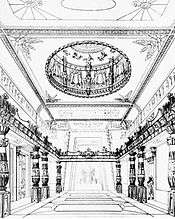Egyptian Hall
The Egyptian Hall in Piccadilly, London, was an exhibition hall built in the ancient Egyptian style in 1812, to the designs of Peter Frederick Robinson. The Hall was a considerable success, with exhibitions of artwork and of Napoleonic era relics. The hall was later used for popular entertainments and lectures, and developed an association with magic and spiritualism, becoming known as "England's Home of Mystery".

In 1905 the building was demolished to make way for flats and offices.
History

The Egyptian Hall was commissioned by William Bullock as a museum to house his collection, which included curiosities brought back from the South Seas by Captain Cook.[1] It was completed in 1812 at a cost of £16,000.[2] It was the first building in England to be influenced by the Egyptian style,[3] partly inspired by the success of the Egyptian Room in Thomas Hope's house in Duchess Street, which was open to the public and had been well illustrated in Hope's Household Furniture and Interior Decoration (London, 1807). Unlike Bullock's Egyptian temple in Piccadilly, Hope's neoclassical façade betrayed no hint of the Egyptianizing decor it contained. Detailed renderings of various temples on the Nile, the Pyramids and the Sphinx had been accumulating for connoisseurs and designers in works such as Bernard de Montfaucon's, ten-volume L'Antiquité expliquée et representée en figures (1719-1724), which reproduces, methodically grouped, all the ancient monuments, Benoît de Maillet's Description de l'Égypte (1735), Richard Pococke's A Description of the East and Some Other Countries (1743), and Frederic Louis Norden's Voyage d'Egypte et de Nubie (1755); the first volume of the magisterial Description de l'Egypte (1810) had recently appeared in Paris. The plans for the hall were drawn up by architect Peter Frederick Robinson.[4] Bullock, who had displayed his collection in Sheffield and Liverpool[5] before opening in London, used the hall to put on various spectaculars, from which he made money from ticket sales. The museum was variously referred to as the London Museum, the Egyptian Hall or Museum, or Bullock's Museum.

The Hall was a considerable success, with an exhibition of Napoleonic era relics in 1816 including Napoleon's carriage taken at Waterloo being seen by about 220,000 visitors;[6] Bullock made £35,000. In 1819, Bullock sold his ethnographical and natural history collection at auction[7] and converted the museum into an exhibition hall. Subsequently, the Hall became a major venue for the exhibiting of works of art; it had the advantage of being almost the only London venue able to exhibit really large works. Usually admission was one shilling. In 1820, The Raft of the Medusa by Théodore Géricault was exhibited from 10 June until the end of the year,[8] rather overshadowing Benjamin Robert Haydon's painting, Christ's Entry into Jerusalem, on show in an adjacent room; Haydon rented rooms to show his work on several occasions. In 1821, exhibitions included Giovanni Battista Belzoni's show of the tomb of Seti I in 1821, and James Ward's gigantic Allegory of Waterloo. In 1822, a family of Laplanders with their reindeer were imported to be displayed in front of a painted backdrop, and give short sleigh-rides to visitors.[9]
The bookseller George Lackington became owner of the Hall in 1825 and went on to use the facilities to show panoramas, art exhibits, and entertainment productions. The Hall became especially associated with watercolours. The old Water-Colour Society exhibited there in 1821–22, and it was hired by Charles Heath to display the watercolours commissioned by from Joseph Mallord William Turner forming Picturesque Views in England and Wales. Turner exhibited at the Hall for a number of years and it was also used as a venue for exhibitions by the Society of Painters in Water Colours.
In the "Dudley Gallery" at the Egyptian Hall, the valuable collection of pictures belonging to the Earl of Dudley was deposited during the erection of his own gallery at Dudley House in Park Lane. The room gave its name to the Dudley Gallery Art Society (also known as The Old Dudley Art Society) when they were founded in 1861 and used it for their exhibitions. It was the venue chosen for their first exhibitions by the influential New English Art Club.
The hall was used principally for popular entertainments and lectures. Here Albert Smith related his ascent of Mont Blanc, illustrated by some cleverly dioramic views of the Alpine peaks.[10]
_p135_-_Arcana%2C_Egyptian_Hall_(advertisement).jpg)
By the end of the nineteenth century, the Hall was also associated with magic and spiritualism, as a number of performers and lecturers had hired it for shows. In 1873 William Morton took on the management of the Hall and modified it for his protegees, Maskelyne and Cooke, whose run there lasted a remarkable 31 years.[11] The Hall became known as England's Home of Mystery. Many illusions were staged including the exposition of fraudulent spiritualistic manifestations then being practised by charlatans. The final performance was on 5 January 1905.[12]
In 1905 the building was demolished to make room for blocks of flats and offices at 170–173 Piccadilly. Muirhead Bone captured its demise in his work The Dissolution of Egyptian Hall. The Maskelynes relocated to the St. George's Hall in Langham Place, which became known as Maskelyne's Theatre.
Hotten documents the name in 1859 used as rhyming slang for a ball. Franklyn comments in 1960 "The term was demolished with the building."[13]
See also
- Egyptian Revival architecture in the British Isles
- Egyptian revival decorative arts
- List of demolished buildings and structures in London
References
- Adrienne L. Kaeppler, "Cook Voyage Provenance of the 'Artificial Curiosities' of Bullock's Museum" Man, New Series, 9.1 (March 1974), pp. 68-92.
- W.H. Mullens, "Some museums of old London: II William Bullock's London Museum", Museum Journal 17 (1917-18) pp 51-56, 132-37, 180-87; Tom Iredale, "Bullock's Museum", Australian Zoology 2 (1948) pp 233-37.
- Howard Colvin, A Biographical Dictionary of British Architects 1600-1840, third ed. (Yale University Press) 1995, s.v. "Robinson, Peter Frederick"; Survey of London vol. xxix.
- Bullock's Egyptian Hall
- William Bullock, A Catalogue of the Liverpool Museum was in its third edition in 1801 (copy in the Liverpool Public Museum, noted by Kaeppler 1974).
- Rowlandson print Archived 3 March 2016 at the Wayback Machine Noon, Patrick & Bann, Stephen. Crossing the Channel: British and French Painting in the Age of Romanticism, pp. 90-91. London: Tate Publishing, 2003. ISBN 1-85437-513-X
- Kaeppler 1974 traces the ethnographic collection from Cook's voyage and clears up many misconceptions about the pieces.
- Riding, Christine. "The Raft of the Medusa in Britain", pp. 15-16 & 72. In: Noon, Patrick & Bann, Stephen. Crossing the Channel: British and French Painting in the Age of Romanticism. London: Tate Publishing, 2003. ISBN 1-85437-513-X
- Noon & Bann, pp. 91-2 (with a print illustrated), prints Archived 26 May 2011 at the Wayback Machine
- "The Egyptian Hall, Piccadilly, London". www.arthurlloyd.co.uk. Retrieved 16 June 2016.
- Hull Daily Mail, 11 February 1937 p. 6 Old-New Maskelyne Trick
- ‘All the Year Round’, The Era, 2 January 1924 p. 6
- Julian Franklyn (1960). A Dictionary of Rhyming Slang. London: Routledge and Keegan Paul. p. 61.